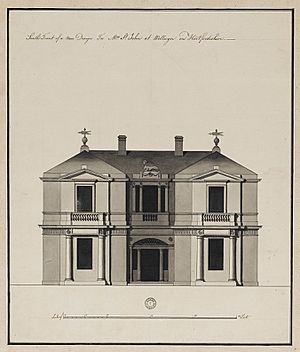William Blake (economist) facts for kids
William Blake (born January 31, 1774 – died 1852) was an important English thinker. He studied how money and economies work. He helped develop early ideas about how the value of money compares between different countries.
His Life Story
William Blake was born in London on January 31, 1774. His parents were William and Alicia Blake. He went to Charterhouse School and then to Trinity College, Cambridge in 1789. He finished his first degree in 1793 and became a Fellow of the college in 1795. This meant he was a senior member of the college.
In 1797, he left his fellowship and began studying law. He became a lawyer in 1799.
Blake was chosen to be a Fellow of the Royal Society in 1807. This is a very old and respected group for scientists. He was also the leader of the Geological Society of London from 1815 to 1816. He joined the Royal Geographical Society in 1830. He was also part of clubs where important people discussed politics and economics.
In 1819, Blake rented a large house called St John's Lodge in Welwyn, Hertfordshire. It had a big park around it. He bought the house in 1824 and changed its name to Danesbury. In 1836, he held an important local position as the High Sheriff of Hertfordshire.
During this time in history, when slavery was ending in the British Empire, the government paid money to people who owned plantations where enslaved people worked. William Blake received payments related to the end of slavery in places like Tobago and Saint Vincent and the Grenadines. This money came from a large loan the British government took out, which was later paid back by British taxpayers.
His Economic Ideas
William Blake was known for his ideas about money. He wrote a book in 1810 called Observations on the Principles Which Regulate the Course of Exchange, and on the Present Depreciated Slate of the Currency. For many years, this book was a key guide for understanding how money's value changes between countries.
Blake also wrote about how government spending affects the economy. His 1823 book on this topic was very important. It even had some ideas that later economists would develop further. Other famous economists, like David Ricardo and John Stuart Mill, discussed Blake's ideas. They sometimes agreed and sometimes disagreed with him. Blake's work helped to show different ways of thinking about how economies work.
Years later, in 1857, another economist named John Ramsay McCulloch republished Blake's 1810 book. He praised it for its important contributions to economic thought.
His Family
William Blake married Mary Nash on July 25, 1797. They had three sons and five daughters.
His sons were:
- William John Blake, who became a politician.
- Frederic Rodolph Blake, who was an army officer.
- Henry Woolaston Blake, who became a partner in a famous engineering company called Boulton & Watt.
His daughters were:
- Mary, who married Wilhelm, Baron de Biel.
- Ellen, who married John Alexander Hankey.
- Caroline, who married Henry Davidson.
- Emily, who married Christopher William Puller.
- Frances (Fanny), who never married.


